



This paper was originally published in the Slide Rule Gazette, Issue 15, Autumn 2014 by the UK Slide Rule Circle.
1. Introduction
Alexander George Thornton is recorded as being apprenticed to William Henry Harling, a London maker of drawing and surveying instruments. Thornton set up in business in 1878 in partnership with Joseph Halden. The partnership was dissolved in 1880 when Thornton set up on his own at 109 Deansgate, Manchester. Over the years the business grew and A G Thornton Ltd became a major manufacturer of slide rules, drawing instruments and surveying instruments, for which the firm held a range of patents. The firm still exists as British Thornton but today is a manufacturer of school furniture.
Although I have entitled the article “Thornton Wooden Slide Rules” I have also included the early, closed frame, plastic slide rules that were part of the ‘standardised’ series introduced in 1955.
2. Before the First World War
In the 1895 A G Thornton catalogue a range of Routledge, Hawthorn’s, and Carrett’s rules are listed, which are not the subject of this article, but only two Mannheim rules are present, namely Faber’s Calculating Slide Rule and Gravet’s Calculating Rule.
However, by 1901 an “improved” range of slide rules was available from Thornton.
Although I have entitled the article “Thornton Wooden Slide Rules” I have also included the early, closed frame, plastic slide rules that were part of the ‘standardised’ series introduced in 1955.
2. Before the First World War
In the 1895 A G Thornton catalogue a range of Routledge, Hawthorn’s, and Carrett’s rules are listed, which are not the subject of this article, but only two Mannheim rules are present, namely Faber’s Calculating Slide Rule and Gravet’s Calculating Rule.
However, by 1901 an “improved” range of slide rules was available from Thornton.
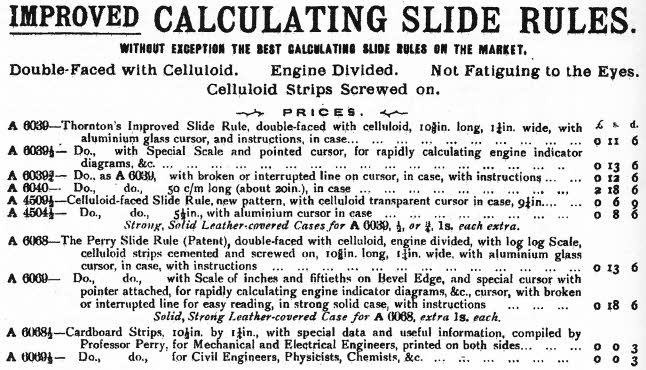
Fig 2.1. Price list of Thornton slide rules from “Particulars and Instructions of Improved Calculating Slide Rules”. UKSRC reprint of A G Thornton original



Figs. 2.2 to 2.4. A G Thornton 6039½ slide rule
The 6039½ slide rule has in the well “DRGM 164885” which is Nestler’s registered design for nickel-silver screws holding on the celluloid facings so the rule was presumably made for Thornton by Nestler. Thornton states that his “improved” slide rules have this feature so presumably the whole range was made in Germany. At this time Thornton also imported a range of flat pattern, machine made, drawing instruments made by E O Richter in Chemnitz. Thornton’s name appears on the cases but the instruments are marked Richter so it would be likely that he also imported the slide rules. However they were not necessarily standard Nestler products as they included Professor John Perry’s patent log-log scales (GB23,236 of 1901). There is a list of eight Thornton’s improved slide rules on the back of the 6039½. There is no model number on the slide rule but it can easily be identified from catalogue and instruction booklet descriptions.
A 6039 on the International Slide Rule Museum website differs slightly in construction and quotes DRP 173,660 of 1903, Nestler’s patent for thin layers of rubber between the back and sides of the stock.
The range of slide rules in the 1916 Thornton catalogue still includes several of the ones from the early instruction booklet, but the range is much increased including specialised rules such as the “Chemist’s, “Electro” and “Chemical”, “Rietz” pattern rules and “Extra Large Rules” with scale lengths from 15 inches to 40 inches. The original “Perry” rule has been replaced by an improved one.
The 6039½ slide rule has in the well “DRGM 164885” which is Nestler’s registered design for nickel-
A 6039 on the International Slide Rule Museum website differs slightly in construction and quotes DRP 173,660 of 1903, Nestler’s patent for thin layers of rubber between the back and sides of the stock.
The range of slide rules in the 1916 Thornton catalogue still includes several of the ones from the early instruction booklet, but the range is much increased including specialised rules such as the “Chemist’s, “Electro” and “Chemical”, “Rietz” pattern rules and “Extra Large Rules” with scale lengths from 15 inches to 40 inches. The original “Perry” rule has been replaced by an improved one.

Fig 2.5. A G Thornton “Improved Perry Slide Rule” from the 1916 catalogue
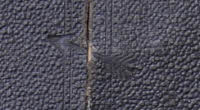
The common features of these rules are the screwed and glued celluloid facings and the aluminium or electrum framed glass cursors. The cut outs in the back of the stock for reading the scales on the reverse of the slide reach the rule ends The cases are black cloth covered with a distinctive arrow mark across the join between the two parts The inner part of the case is wood.
There is also a very cheap slide rule for students, the “Kensington” slide rule, made of varnished boxwood with a folded celluloid cursor, priced at two shillings
There is also a very cheap slide rule for students, the “Kensington” slide rule, made of varnished boxwood with a folded celluloid cursor, priced at two shillings
Fig 2.6. “Arrow” case mark on pre-WWI cases

Fig 2.7. The “Kensington” student’s slide rule from the 1916 catalogue
The catalogue also listed many specialised slide rules, a selection of Faber slide rules, and watch form slide rules but these are not the subject of this article.
In conclusion I believe the first world war brought about the end of the slide rules being imported, as indeed it did with the Richter drawing instruments, and led, eventually, to in-house manufacture by Thornton.
3. The metal-backed slide rules
These seem to have been the first series to have the PIC trade mark. It is difficult to be certain of the time frame for their manufacture as they pre-date the stamping of a date code on the back of the rule.
The catalogue also listed many specialised slide rules, a selection of Faber slide rules, and watch form slide rules but these are not the subject of this article.
In conclusion I believe the first world war brought about the end of the slide rules being imported, as indeed it did with the Richter drawing instruments, and led, eventually, to in-
3. The metal-
The use of a spring metal back is more usually associated with Japanese bamboo slide rules, and particularly those of Hemmi (“Sun”). However John Davis & Son Ltd of Derby slide rules also had this type of backing plate. The cuts outs in the back of the stock to read the scales on the reverse of the slide are enclosed ovals. The celluloid faces are pinned and glued on. I also believe that Nestler (Thornton’s pre-WWI supplier) and/or Dennert & Pape (who supplied slide rules to Davis pre-WWI) also made metal backed slide rules. One such slide rule is illustrated in a Gebrüder Wichmann catalogue although it is not actually stated who made it. The DRP referred to is presumably the Dennert & Pape one, 126,499, of 1901.

Fig 3.1 Slide rule with steel back from the Wichmann instruction book and catalogue “ANLEITUNG ZUM GEBRAUCH DES RECHENSTABES”
In fact John Davis & Son had patented this method of construction in 1916, (GB101,051), having commenced slide rule manufacture before the war.


Figs 3.2, 3.3. John Davis & Son “Autocrat” slide rule retailed by A G Thornton.


Figs 3.4, 3.5. A G Thornton metal backed slide rule
The first pair of pictures shows a Davis Autocrat slide rule retailed by Thornton. There is a Thornton paper label on the case. I presume that Thornton turned to Davis for its supply of slide rules when the stock of slide rules from Germany ran out during the war. Blind stamped into the end of the slide is the number “816” - I shall discuss this later on. The case is a typical Davis product, brownish-maroon coloured, with a star mark each side of the join between the case halves.
The second pair of pictures shows a PIC branded slide rule. The construction of the stock and slide is identical to the Davis Autocrat rule but the cursor and scales are different.
Davis - metal framed cursor; A & B scales numbered 1,2,…..9,1,2,…..9,1
PIC - “frameless” cursor as used on the next series of slide rules, numbered 1,2,…..9,10,20,…….90,100. This is a Thornton characteristic that continued (but not universally) to the end of slide rule production. The example I have has a press-stud fastening, black, cloth-covered card case. It also has the tables on the reverse, over the metal plate, that are the tables that continued to be used on the reverse of Thornton ten inch slide rules until the end of wooden slide rule production and which differ from the Davis tables on the Autocrat.
It seems possible that the stock and slide were manufactured by Davis for finishing by Thornton.
4. The first series with celluloid backs, which have frameless cursors
The first pair of pictures shows a Davis Autocrat slide rule retailed by Thornton. There is a Thornton paper label on the case. I presume that Thornton turned to Davis for its supply of slide rules when the stock of slide rules from Germany ran out during the war. Blind stamped into the end of the slide is the number “816” -
The second pair of pictures shows a PIC branded slide rule. The construction of the stock and slide is identical to the Davis Autocrat rule but the cursor and scales are different.
Davis -
PIC -
It seems possible that the stock and slide were manufactured by Davis for finishing by Thornton.
4. The first series with celluloid backs, which have frameless cursors


This series is illustrated in a number of catalogues - Harling, Halden, and Norton & Gregory for example, which might lead one to believe that this series was available from at least ca.1925 to 1938. However I am not entirely confident that the Halden catalogue is as early as 1925 (although the latest patent quoted is a 1924 one and Halden had more patents from 1925 on in the 1920s) and the 1938 Norton & Gregory one shows the later framed cursor in some illustrations. It is well known that blocks were used from earlier editions and did not always show the latest version. Where cursors have been broken the replacement may be a later pattern.

A feature of these slide rules and the earlier patterns (sections 2 and 3) is that they have rulers (usually inch and metric) on both edges. One edge is at right angles to the faces whilst the other slopes at about 70 degrees so that the back is wider than the front. On the back this shows as one narrow and one wide mahogany edge.
Another feature of this series is that the slide is usually longer than the stock (except for the engineering slide rules with scales in the well, which have a wedge-shaped, metal indicator for reading the well scales fitted to one end of the slide)
Both dated examples I have of this series were made in 1931. They have green cloth covered card cases with the ‘tree’ mark either side of the join.
Another feature of this series is that the slide is usually longer than the stock (except for the engineering slide rules with scales in the well, which have a wedge-
Both dated examples I have of this series were made in 1931. They have green cloth covered card cases with the ‘tree’ mark either side of the join.
Fig 4.3’Tree’ case mark
Figs 4.1, 4.2. Thornton engineer’s slide rule dated 1931
5. The second series with celluloid backs
These are generally similar to the first series (section 4) but have three-part, aluminium framed, glass cursors that have a screw in each corner or, sometimes, an optional frameless cursor of a slightly different design to those on the first series. They too have one edge vertical and one sloping at about 70 degrees. Most framed cursors have the cursor number stamped on one edge (e.g. PC2A, PC6A, PC7A). Some late examples have painted steel cursors. Again the slide is usually longer than the stock except for rules with scales in the well. However during this period the shape of the metal indicator on the left-hand end of the slide of the engineering rules changed from a wedge to a mushroom.
These are generally similar to the first series (section 4) but have three-


Figs 5.1, 5.2. Slide rule dated 1938. Note the short-lived return to oval cut-outs in the rear of the stock.


Figs 5.3, 5.4. PIC No 4865 Engineers slide rule dated 1944. Note the painted steel cursor and the mushroom shaped index for the scales in the well


Figs 5.5, 5.6. PIC No 101 slide rule dated 1935.
The earliest slide rule I have with this type of cursor is dated 1933 and the latest generally available one is dated 1945. One made for the Royal Artillery dated 1950, however, still has this pattern of cursor, in this case one wide and one narrow, and also the same edges to the stock, rather than the series 3 type - presumably the RA did not change their specification to keep up with the Thornton changes as the series 3 type were manufactured from 1946 onwards.
During this period the differential scales patented by H Boardman were introduced. There were actually two types of differential scales, the Trig ones along the centre of the slide, and the Direct & Inverse Log-Log ones for finance and (1 + x) n calculations (Patent 411090 of 1933). Also during this period Thornton started putting the model number in the well of the slide rule. The earliest dated example I have with a model number in the well is a 101, dated 1935. There are two number series: the rules with plain backs to the slides (those with differential scales and the AC electrical rules) have three figure model numbers starting with 100; those with trig scales on the back of the slide have four figure numbers with a 3 or 4 as the first figure. The three figure numbers were probably introduced when the models with differential scales were introduced and certainly by 1935, but the four figure numbers don’t appear to have been introduced until later (probably not before 1940 as a 1939 example has no model number)
See Colin Barnes Slide Rule 05 paper for slide rules listed in the 1934 and 1937 Thornton catalogues
The earliest slide rule I have with this type of cursor is dated 1933 and the latest generally available one is dated 1945. One made for the Royal Artillery dated 1950, however, still has this pattern of cursor, in this case one wide and one narrow, and also the same edges to the stock, rather than the series 3 type -
During this period the differential scales patented by H Boardman were introduced. There were actually two types of differential scales, the Trig ones along the centre of the slide, and the Direct & Inverse Log-
See Colin Barnes Slide Rule 05 paper for slide rules listed in the 1934 and 1937 Thornton catalogues
The rules with differential scales and the AC Electrical rules have slides with plain backs so there are no cut-outs in the back of the stock. A 1933 dated “Perry” type of log-log rule has the open ended cut-outs. However 1936 and 1938 enhanced Mannheim types (one with a reciprocal scale) and a 1939 dated electrical and mechanical engineer’s slide rule all have closed oval cut-outs. A 1944 dated No. 4865 reverts to open ended cut-outs and these are used on all future slide rules that have scales on the back of the slide.
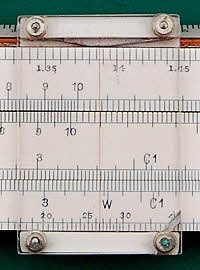
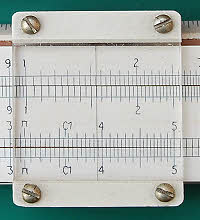
Figs 5.7, 5.8. Early and later types of frameless cursor
The cases for these slide rules are the same as for the previous series until ca.1943 and it is only my distinction that they are two different series as the only real difference is the cursor type. Both framed and frameless cursors can be seen illustrated on different rules in the 1935 revised prices version of the 1930 A West & Partners catalogue. A 1930s Harper & Tunstall catalogue with a 1937 pasted in revised price list shows PIC slide rues with frameless cursors but lists both framed and frameless cursors as spares (and also magnifying ones). However actual rules seen with frameless cursors dating from 1937 or later ( stamped Made in England) have a different type of screw from those on the series 1 rules.
There was a variation in the framed cursor design on some rules dated 1943 to 1945. A number of rules have been found where the cursor has a metal frame with wooden side pieces and metal running edges in the cursor groove. Four screws pass through the wooden parts into tapped holes in the metal running edges. This is presumed to have been a wartime economy measure. It is also likely that the painted steel cursors mentioned earlier were a wartime measure to conserve stocks of aluminium.
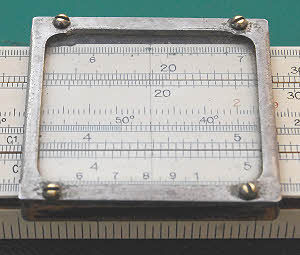
The case style changed ca.1943 (not all changed then, presumably as old stocks were used up) to green cloth-covered with a diamond mark each side of the join and the embossed border was moved much further in from the edges. Another minor change occurred some time between 1938 and 1943; the typeface for the table on the reverse changed from a serif one to sans-serif.
Fig 5.9. Metal cursor with wooden side pieces
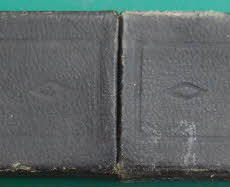
Fig 5.10. Diamond case mark
The country of origin stamp in the well changed from “British Made” (up to 1936) to “Made in England” (from 1937).
Thornton are also known to have made slide rules for W F Stanley and I have a five inch slide rule marked Stanley (no PIC trade mark) that appears to be a Thornton slide rule. It is stamped “British Made” and has the later type of frameless cursor
The case is similar to other Thornton 5 inch slide rule cases with the ‘star’ mark each side of the join but is maroon. The back of this slide rule is plain polished mahogany.
Thornton are also known to have made slide rules for W F Stanley and I have a five inch slide rule marked Stanley (no PIC trade mark) that appears to be a Thornton slide rule. It is stamped “British Made” and has the later type of frameless cursor
The case is similar to other Thornton 5 inch slide rule cases with the ‘star’ mark each side of the join but is maroon. The back of this slide rule is plain polished mahogany.
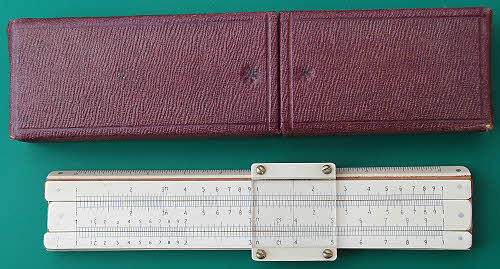
Fig 5.11. W F Stanley five inch slide rule believed made by A G Thornton
6. The “Junior” slide rules
These were lower priced slide rules for students, produced in parallel with the precision series.

Fig 6.1. PIC Junior slide rule
These slide rules do not have edge scales and both edges are perpendicular to the faces. The slide is longer than the stock and they have metal edged, frameless celluloid cursors. They have black, cloth covered, card cases. They are undated. They appear in the ca.1925 Halden, ca.1930 Casella, and 1938 Norton & Gregory catalogues although they are called “Student’s” rather than “Junior” slide rules. Since both the Junior rules in my collection are stamped “Made in England” they must be 1937 or later suggesting that they continued to be manufactured later than 1938. However earlier examples are known with the series 2 metal framed cursor.
Two versions existed, one with just the A/B,C/D scale configuration and the other with additional S/L/T scales on the back of the slide and open ended cut-outs in the stock for reading these trig and mantissa scales.
7. The third series with celluloid backs
These are distinctively different from the previous series; many are wider and they now have both edges bevelled at 70 degrees from the horizontal. The metal frame of the cursor is now a single piece of aluminium rather than three screwed together.
These slide rules do not have edge scales and both edges are perpendicular to the faces. The slide is longer than the stock and they have metal edged, frameless celluloid cursors. They have black, cloth covered, card cases. They are undated. They appear in the ca.1925 Halden, ca.1930 Casella, and 1938 Norton & Gregory catalogues although they are called “Student’s” rather than “Junior” slide rules. Since both the Junior rules in my collection are stamped “Made in England” they must be 1937 or later suggesting that they continued to be manufactured later than 1938. However earlier examples are known with the series 2 metal framed cursor.
Two versions existed, one with just the A/B,C/D scale configuration and the other with additional S/L/T scales on the back of the slide and open ended cut-
7. The third series with celluloid backs
These are distinctively different from the previous series; many are wider and they now have both edges bevelled at 70 degrees from the horizontal. The metal frame of the cursor is now a single piece of aluminium rather than three screwed together.


Figs 7.1, 7.2. PIC No. 4458 slide rule dated 1951


Figs 7.3, 7.4. PIC No. 101 slide rule dated 1956. Comparison with Figs 5.5 and 5.6 shows how much wider some series three rules were.
The cases are still green cloth covered card with the diamond mark each side of the join. The cloth covering is sometimes textured and sometimes plain. From 1953 on wards (or possibly 1952) the PIC trade mark and model number appear on the case. Leather cases were optional for an additional cost.
The cases are still green cloth covered card with the diamond mark each side of the join. The cloth covering is sometimes textured and sometimes plain. From 1953 on wards (or possibly 1952) the PIC trade mark and model number appear on the case. Leather cases were optional for an additional cost.
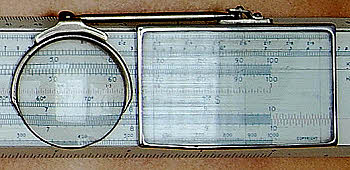
There were also optional cursors including a three line cursor and the type with a hinged, adjustable magnifier, again at an extra cost
Fig 7.5. The hinged magnifying cursor on a PIC No 132, twenty-inch slide rule
From dates on slide rules in my collection it is clear that these were manufactured from 1946 to 1956.
From this period I have a Stanley branded PIC No. 3654 slide rule which has an unusual metal appendage (presumably a handle; it is not an indicator as there are no scales in the well) attached to the right hand end of the slide.
From dates on slide rules in my collection it is clear that these were manufactured from 1946 to 1956.
From this period I have a Stanley branded PIC No. 3654 slide rule which has an unusual metal appendage (presumably a handle; it is not an indicator as there are no scales in the well) attached to the right hand end of the slide.


Figs 7.6, 7.7. W F Stanley PIC No 3654 slide rule dated 1951. Note the ‘handle’ on the right-hand end.
8. The fourth (last series) of wooden rules
According to reference ix Thornton initiated a standardisation of their slide rule range in October 1955 and began to offer plastic slide rules as an alternative to their laminated mahogany range. These are covered in the following section. However the laminated mahogany range also underwent a transformation at about this time. The rules generally became yet wider, the slide became the same length as the stock, and the cursor was redesigned with a thinner, curved, nickel plated metal frame. The slide rule model designation now included the cursor type and sometimes a preceding letter (e.g. F3654/PC8, 112/PC9). Both edges are bevelled.
8. The fourth (last series) of wooden rules
According to reference ix Thornton initiated a standardisation of their slide rule range in October 1955 and began to offer plastic slide rules as an alternative to their laminated mahogany range. These are covered in the following section. However the laminated mahogany range also underwent a transformation at about this time. The rules generally became yet wider, the slide became the same length as the stock, and the cursor was redesigned with a thinner, curved, nickel plated metal frame. The slide rule model designation now included the cursor type and sometimes a preceding letter (e.g. F3654/PC8, 112/PC9). Both edges are bevelled.
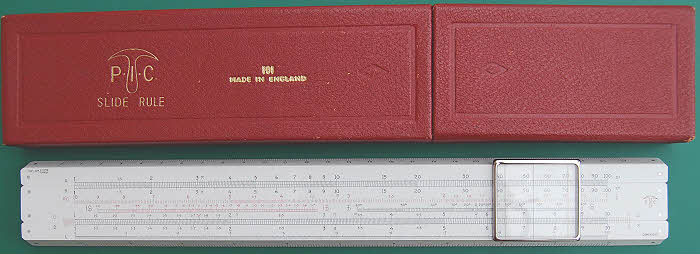

Figs 8.1, 8.2. PIC No. 101/PC8 slide rule dated 1960. This is wider again than the rule shown in Figs 7.3 and 7.4.
The case colour is now generally red, still with the diamond marks. The embossed border appears on cases up to 1960 but not thereafter and the last dated rule I have is 1961 but I have some undated (presumably later) rules, one of which has a buff coloured case.
9. The early plastic (closed frame) slide rules
The appendix to reference ix lists the slide rules and accessories in Thornton catalogueT.C.3 of 1956 including both mahogany and plastic versions and it is convenient to split the plastic versions into three types - Precision (comprising the “Differentialism”, “Comprehensive”, “Standard”, and “Specialist” series), Student (the “Student” series), and Advertising (the “Kinwest” series).
Generally these had the same style of cursor as the fourth series of mahogany slide rules and, except for the vest pocket versions had red, cloth-covered, card cases. None of these rules appear to have been date coded.
All these rules are laminated sheet Astralon (PVC).
The case colour is now generally red, still with the diamond marks. The embossed border appears on cases up to 1960 but not thereafter and the last dated rule I have is 1961 but I have some undated (presumably later) rules, one of which has a buff coloured case.
9. The early plastic (closed frame) slide rules
The appendix to reference ix lists the slide rules and accessories in Thornton catalogueT.C.3 of 1956 including both mahogany and plastic versions and it is convenient to split the plastic versions into three types -
Generally these had the same style of cursor as the fourth series of mahogany slide rules and, except for the vest pocket versions had red, cloth-
All these rules are laminated sheet Astralon (PVC).


Figs 9.1, 9.2. PIC No. 3648/PC8 plastic slide rule.
The 3648/PC8 is an example of a ‘Precision’ plastic slide rule. The edge rulers are placed at a much shallower angle to the horizontal and thus much more convenient to use and the whole rule is thinner and lighter than the equivalent mahogany version
The 3648/PC8 is an example of a ‘Precision’ plastic slide rule. The edge rulers are placed at a much shallower angle to the horizontal and thus much more convenient to use and the whole rule is thinner and lighter than the equivalent mahogany version
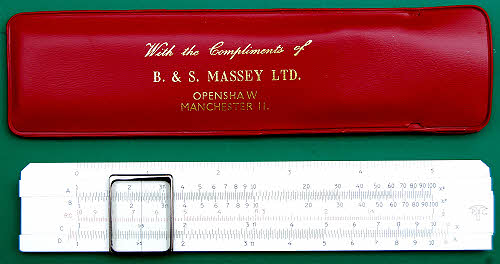
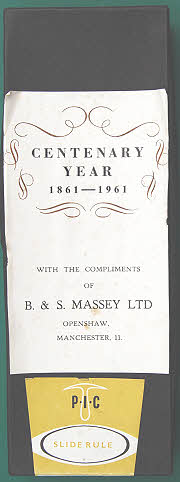
Figs 9.3, 9.4. PIC VP150/PC2A slide rule, PVC slip case and outer retail box.
The VP150/PC2A dating from 1961 is typical of the plastic, vest pocket slide rules in its construction but is actually an advertising rule. Whilst the ‘Precision’ vest pocket slide rules had leather slip cases this has a red PVC one. It is interesting to note that it is totally different from the open frame VP150 shown on page 17 of reference ix. The vest pocket, plastic slide rules typically have one ruler on the upper edge, inclined at a shallow angle to the faces. However a “Kinwest” branded VP15 on the International Slide Rule Museum website has rulers on both edges and a plastic cursor.
The VP150/PC2A dating from 1961 is typical of the plastic, vest pocket slide rules in its construction but is actually an advertising rule. Whilst the ‘Precision’ vest pocket slide rules had leather slip cases this has a red PVC one. It is interesting to note that it is totally different from the open frame VP150 shown on page 17 of reference ix. The vest pocket, plastic slide rules typically have one ruler on the upper edge, inclined at a shallow angle to the faces. However a “Kinwest” branded VP15 on the International Slide Rule Museum website has rulers on both edges and a plastic cursor.

Fig 9.5. PIC No. P171 stident’s slide rule.
The plastic “Student” slide rules (P170, P171, P172, P173 and P172E) are similar in construction to the other types but do not have edge rulers and the edges are perpendicular to the faces. Like the vest pocket rules, they do not have the metal spring strips in the stock to maintain the tension on the slide that are present in the ten inch ‘Precision’ slide rules.
10. The “Advanced” series of slide rules
Colin Barnes, in reference ix, includes pictures of a couple of mahogany examples as well as extracts from Thornton literature. It appears that these were either prototypes or from very limited production. Examples appear to be extremely rare and I can add nothing to the material in reference ix.
11. Conclusions
These conclusions are somewhat tentative, being based on my observations of actual slide rules, previously published papers, and catalogue descriptions. As previously noted catalogues often had illustrations that were carried over from previous editions and did not necessarily portray the version in production at that time. Some rules examined may have had replacement cursors. Some conclusions are based on circumstantial evidence.
The earliest range of celluloid faced mahogany slide rules date from about 1901 up to the First World War. They were made in Germany by Albert Nestler of Lahr, in some cases to Thornton designs. They were followed by slide rules with spring metal backing plates, possibly made from some time in WWI until the early 1920s. The first of these were standard John Davis & Son products retailed by Thornton. These were followed by the first PIC branded slide rules with framelesss cursors. The stock and slide for these may have been made by Davis for finishing by Thornton.
From at least 1925 the familiar mahogany slide rules, faced on all sides with celluloid were produced. Until 1931 or possibly 1932 these had the same type of frameless cursor as the later spring metal backed rules. From 1933 until 1945 they had 3 piece aluminium framed cursors or sometimes a later form of ivorine and glass frameless cursor. These rules had one vertical and one sloping edge.
The use of date codes on the back of Thornton slide rules seems to have been current from at least 1931 until 1961. Model numbers first appeared on the slide rules ca.1935.
From 1946 the rules had two sloping edges and were generally wider. They were fitted with one-piece aluminium framed cursors (or occasionally the earlier three-piece type) and continued in production until 1956.
In October 1955 a new range of standardised slide rules was announced including both celluloid faced mahogany and laminated PVC types. In some cases slide rules were available in both materials. Some are believed to have continued in production beyond the introduction of the open frame P221, P241, P251, P271 and P281 ten-inch slide rules ca.1963.
The mahogany slide rules had cloth covered card cases. The Junior series, the pre-WWI rules, and the PIC metal backed rules had black cases. The rules produced between ca.1925 and 1956 had green cases. Leather cases were an option. The ‘standardised’ range, introduced in 1955, had red cases or, sometimes, buff ones.
ACKNOWLEDGEMENTS
I would like to thank Peter Hopp and Colin Barnes for their help and encouragement whilst I was producing this article and also John Oakhill for his correspondence on dating Thornton slide rules in 2009.
The plastic “Student” slide rules (P170, P171, P172, P173 and P172E) are similar in construction to the other types but do not have edge rulers and the edges are perpendicular to the faces. Like the vest pocket rules, they do not have the metal spring strips in the stock to maintain the tension on the slide that are present in the ten inch ‘Precision’ slide rules.
10. The “Advanced” series of slide rules
Colin Barnes, in reference ix, includes pictures of a couple of mahogany examples as well as extracts from Thornton literature. It appears that these were either prototypes or from very limited production. Examples appear to be extremely rare and I can add nothing to the material in reference ix.
11. Conclusions
These conclusions are somewhat tentative, being based on my observations of actual slide rules, previously published papers, and catalogue descriptions. As previously noted catalogues often had illustrations that were carried over from previous editions and did not necessarily portray the version in production at that time. Some rules examined may have had replacement cursors. Some conclusions are based on circumstantial evidence.
The earliest range of celluloid faced mahogany slide rules date from about 1901 up to the First World War. They were made in Germany by Albert Nestler of Lahr, in some cases to Thornton designs. They were followed by slide rules with spring metal backing plates, possibly made from some time in WWI until the early 1920s. The first of these were standard John Davis & Son products retailed by Thornton. These were followed by the first PIC branded slide rules with framelesss cursors. The stock and slide for these may have been made by Davis for finishing by Thornton.
From at least 1925 the familiar mahogany slide rules, faced on all sides with celluloid were produced. Until 1931 or possibly 1932 these had the same type of frameless cursor as the later spring metal backed rules. From 1933 until 1945 they had 3 piece aluminium framed cursors or sometimes a later form of ivorine and glass frameless cursor. These rules had one vertical and one sloping edge.
The use of date codes on the back of Thornton slide rules seems to have been current from at least 1931 until 1961. Model numbers first appeared on the slide rules ca.1935.
From 1946 the rules had two sloping edges and were generally wider. They were fitted with one-
In October 1955 a new range of standardised slide rules was announced including both celluloid faced mahogany and laminated PVC types. In some cases slide rules were available in both materials. Some are believed to have continued in production beyond the introduction of the open frame P221, P241, P251, P271 and P281 ten-
The mahogany slide rules had cloth covered card cases. The Junior series, the pre-
ACKNOWLEDGEMENTS
I would like to thank Peter Hopp and Colin Barnes for their help and encouragement whilst I was producing this article and also John Oakhill for his correspondence on dating Thornton slide rules in 2009.
APPENDICES
Appendix 1, pages from the 1916 catalogue
Appendix 1, pages from the 1916 catalogue
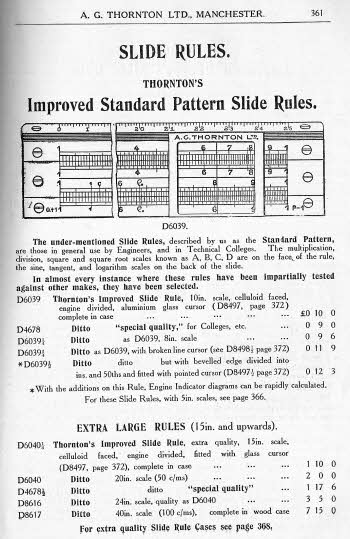
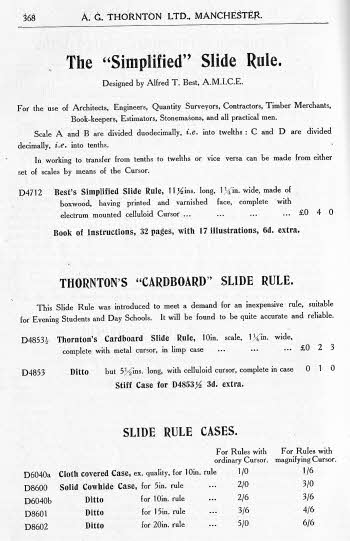

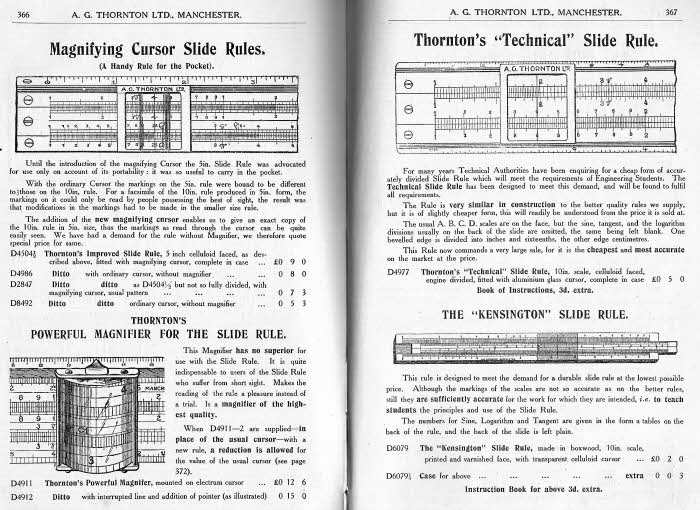

i. Maya Hambly, Drawing Instruments 1580-1980, Sotheby’s Publications 1988, p30
ii. Particulars and Instructions of Improved Calculating Slide Rules, A G Thornton, UKSRC 2005 reprint, p5, “Important Testimonial”
iii. Drawing Surveying & Scientific Instruments and Drawing Office Materials, A G Thornton Ltd, D1916 edition, pp361-372
iv. Catalogue of Mathematical Drawing & Surveying Instruments, W H Harling Ltd, September 1930, p65
v. J Halden & Co Ltd catalogue, undated but ca.1925, p114
vi. Norton & Gregory Ltd catalogue, Section 3, 1938 edition, pp157-158
vii. Book of Instructions (T) for the use of the PIC Differential Scales for Trigonometrical Computations, H Boardman, , Thornton booklet no 81
viii. Book of Instructions for the use of the PIC Direct & Inverse Log-Log Differential Scales for (1+x) n Expansions and Finance Calculations, H Boardman, A G Thornton booklet
ix. Colin Barnes, A G Thornton & British Thornton Slide Rules, Slide Rule ‘05, pp7-24
x. A West & Partners catalogue June 1930, revised May 1935, pp132-133
xi. Catalogue, Harper & Tunstall Ltd, pre-1937, pp38, 40
xii. http://www.sliderulemuseum.com/
iii. Drawing Surveying & Scientific Instruments and Drawing Office Materials, A G Thornton Ltd, D1916 edition, pp361-
v. J Halden & Co Ltd catalogue, undated but ca.1925, p114
vi. Norton & Gregory Ltd catalogue, Section 3, 1938 edition, pp157-
viii. Book of Instructions for the use of the PIC Direct & Inverse Log-
ix. Colin Barnes, A G Thornton & British Thornton Slide Rules, Slide Rule ‘05, pp7-
| Early Sets |
| Traditional Sets |
| Later Sets |
| Major Makers |
| Instruments |
| Miscellanea |
| W F Stanley |
| A G Thornton |
| W H Harling |
| Elliott Bros |
| J Halden |
| Riefler |
| E O Richter |
| Kern, Aarau |
| Keuffel & Esser |
| Compasses |
| Pocket compasses |
| Beam compasses |
| Dividers |
| Proportional dividers |
| Pens |
| Pencils |
| Rules |
| Protractors |
| Squares |
| Parallels |
| Pantographs |
| Sectors |
| Planimeters |
| Map Measurers |
| Miscellaneous |
| Materials Used |
| Who made them |
| Who made these |
| Addiator |
| Addimult |
| Other German |
| USA |
| Miscellaneous |
| Microscopes |
| Barometers |
| Hydrometers & Scales |
| Pedometers |
| Other instruments |
| Workshop Measuring Tools |
| Catalogues & Brochures |